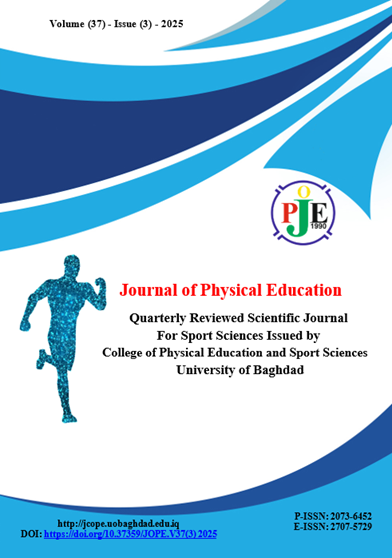The Effect of Nutritional Supplements and Rehabilitation Exercises on The Functional Adequacy of The Injured Deltoid Muscle in Bodybuilders
DOI:
https://doi.org/10.37359/JOPE.V37(3)2025.2230الكلمات المفتاحية:
Functional competence، nutritional supplements، body building، rehabilitative exercises.الملخص
This study aimed to identify the effect of nutritional supplements and rehabilitative exercises on the functional recovery of advanced bodybuilding players with anterior deltoid injuries. The experimental method was applied to two groups of eight injured athletes from the Baghdad/Al-Rusafa Gym. The first group performed rehabilitative exercises, while the second group combined them with nutritional supplements. Functional competence was assessed through measurements of muscle strength and range of motion using a dynamometer. The results showed significant improvement in both groups, with the combined program producing greater recovery. The study concluded that integrating nutritional supplements with rehabilitation exercises effectively restores the anterior deltoid muscle’s function and accelerates the return of injured bodybuilders to normal performance.
المراجع
Abdel Fattah, A. A. (1997). Sports training (physiological foundations) (1st ed.). Cairo: Dar Al-Fikr Al-Arabi.
Abdel Fattah, A. A. (2003). Physiology of training and sports (1st ed.). Cairo: Dar Al-Fikr Al-Arabi.
Abdel Fattah, A. A. (2012). Contemporary sports training (1st ed.). Cairo: Dar Al-Fikr Al-Arabi.
Abdel Fattah, A. A., & El-Din, A. N. (1993). Fitness physiology (1st ed.). Cairo: Dar Al-Fikr Al-Arabi.
Abdel Fattah, A. A., & Hassanein, M. S. (1997). Physiology and morphology of the athlete and methods of measurement and evaluation (1st ed.). Cairo: Dar Al-Fikr Al-Arabi.
Abdel Fattah, A. A., & Selim, L. S. (1999). Sports and immunity. Cairo: Dar Al-Fikr Al-Arabi.
Al-Beggar, A. A. (2013). Weightlifting sport (1st ed.). Amman: Arab Society Library.
American College of Sports Medicine. (2021). ACSM’s guidelines for exercise testing and prescription (11th ed.). Wolters Kluwer.
Behm, D. G., & Chaouachi, A. (2011). A review of the acute effects of static and dynamic stretching on performance. European Journal of Applied Physiology, 111(11), 2633–2651.
Farag, A. W., & Ezz El-Din, S. (2002). Reference in table tennis (education and training). Alexandria: Delta Printing Center.
Folland, J. P., & Williams, A. G. (2007). The adaptations to strength training: Morphological and neurological contributions to increased strength. Sports Medicine, 37(2), 145–168.
Kraemer, W. J., & Ratamess, N. A. (2004). Fundamentals of resistance training: Progression and exercise prescription. Medicine & Science in Sports & Exercise, 36(4), 674–688.
Magnusson, S. P., Simonsen, E. B., Aagaard, P., & Kjaer, M. (1996). Biomechanical responses to repeated stretches in human hamstring muscle in vivo. The American Journal of Sports Medicine, 24(5), 622–628.
Schoenfeld, B. J. (2010). The mechanisms of muscle hypertrophy and their application to resistance training. Journal of Strength and Conditioning Research, 24(10), 2857–2872.
التنزيلات
منشور
إصدار
القسم
الرخصة
الحقوق الفكرية (c) 2025 Journal of Physical Education

هذا العمل مرخص بموجب Creative Commons Attribution-NonCommercial 4.0 International License.






